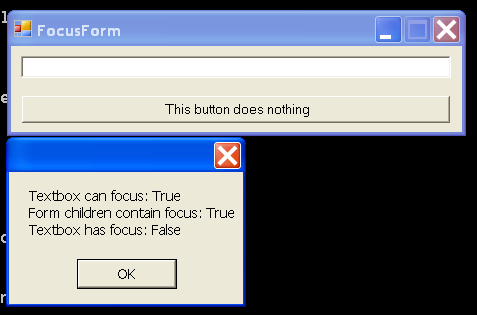Focus Form

/*
Professional Windows GUI Programming Using C#
by Jay Glynn, Csaba Torok, Richard Conway, Wahid Choudhury,
Zach Greenvoss, Shripad Kulkarni, Neil Whitlow
Publisher: Peer Information
ISBN: 1861007663
*/
using System;
using System.Drawing;
using System.Collections;
using System.ComponentModel;
using System.Windows.Forms;
using System.Data;
namespace Wrox.ProgrammingWindowsGUI.Chapter5
{
/// <summary>
/// Summary description for Form1.
/// </summary>
public class FocusForm : System.Windows.Forms.Form
{
private System.Windows.Forms.TextBox txtFocusForm;
private System.Windows.Forms.Button btFocusForm;
/// <summary>
/// Required designer variable.
/// </summary>
private System.ComponentModel.Container components = null;
public FocusForm()
{
//
// Required for Windows Form Designer support
//
InitializeComponent();
//
// TODO: Add any constructor code after InitializeComponent call
//
}
/// <summary>
/// Clean up any resources being used.
/// </summary>
protected override void Dispose( bool disposing )
{
if( disposing )
{
if (components != null)
{
components.Dispose();
}
}
base.Dispose( disposing );
}
#region Windows Form Designer generated code
/// <summary>
/// Required method for Designer support - do not modify
/// the contents of this method with the code editor.
/// </summary>
private void InitializeComponent()
{
this.txtFocusForm = new System.Windows.Forms.TextBox();
this.btFocusForm = new System.Windows.Forms.Button();
this.SuspendLayout();
//
// txtFocusForm
//
this.txtFocusForm.Location = new System.Drawing.Point(8, 8);
this.txtFocusForm.Name = "txtFocusForm";
this.txtFocusForm.Size = new System.Drawing.Size(336, 20);
this.txtFocusForm.TabIndex = 0;
this.txtFocusForm.Text = "";
this.txtFocusForm.LostFocus += new System.EventHandler(this.txtFocusForm_LostFocus);
this.txtFocusForm.GotFocus += new System.EventHandler(this.txtFocusForm_GotFocus);
//
// btFocusForm
//
this.btFocusForm.Location = new System.Drawing.Point(8, 40);
this.btFocusForm.Name = "btFocusForm";
this.btFocusForm.Size = new System.Drawing.Size(336, 23);
this.btFocusForm.TabIndex = 1;
this.btFocusForm.Text = "This button does nothing";
this.btFocusForm.Click += new System.EventHandler(this.btFocusForm_Click);
//
// FocusForm
//
this.AutoScaleBaseSize = new System.Drawing.Size(5, 13);
this.ClientSize = new System.Drawing.Size(352, 70);
this.Controls.AddRange(new System.Windows.Forms.Control[] {
this.btFocusForm,
this.txtFocusForm});
this.MaximizeBox = false;
this.Name = "FocusForm";
this.Text = "FocusForm";
this.ResumeLayout(false);
}
#endregion
/// <summary>
/// The main entry point for the application.
/// </summary>
[STAThread]
static void Main()
{
Application.Run(new FocusForm());
}
protected void txtFocusForm_LostFocus(object sender, EventArgs e)
{
// MessageBox.Show("Goodbye!");
}
protected void txtFocusForm_GotFocus(object sender, EventArgs e)
{
// MessageBox.Show("Hello!");
}
private void btFocusForm_Click(object sender, System.EventArgs e)
{
bool canFocus = txtFocusForm.CanFocus;
bool containsFocus = this.ContainsFocus;
bool focused = txtFocusForm.Focused;
MessageBox.Show("Textbox can focus: " + canFocus +
"\nForm children contain focus: " + containsFocus +
"\nTextbox has focus: " + focused);
txtFocusForm.Focus();
}
}
}
Related examples in the same category